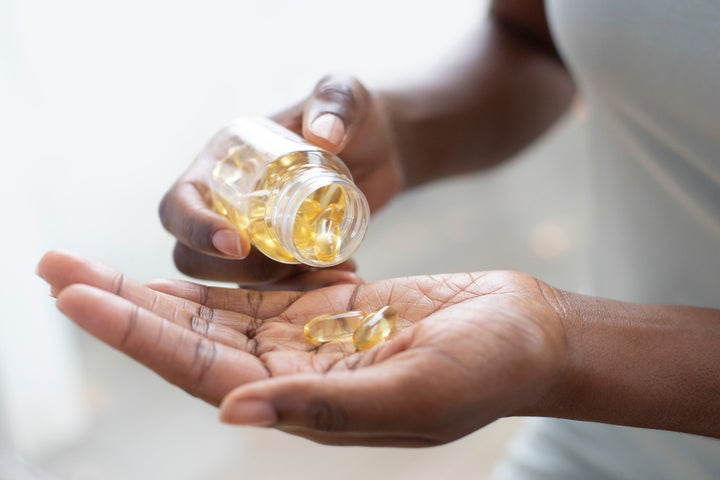
Vitamin D probably brings to mind sunshine and healthy, strong bones — and that’s not wrong.
Dr. Jad Sfeir, an endocrinologist and geriatrician at Mayo Clinic, said vitamin D is essential for the absorption of minerals in our gut. It’s key to the absorption of calcium and phosphorus — without vitamin D these minerals are not absorbed to the level the body needs for the development of a healthy skeleton.
The recommended daily amount of vitamin D for adults and children is 600 international units, or IU. For those 70 and older, you’ll need 800 IU of vitamin D each day. Children under 12 months need 400 IU daily, according to the Mayo Clinic.
The sun has long been touted as the best source of vitamin D, and it can be ― just not during the winter months. But how important is vitamin D for healthy people, anyway?
New large-scale research shows vitamin D may not actually have as many health perks as we once thought, according to Dr. Gregory Clines, an associate professor of internal medicine in the division of metabolism, endocrinology and diabetes at the University of Michigan.
Here’s what to know about your vitamin D needs — and if it’s important for you — as we head into a time of less sunlight.
You can generally get your daily dose of vitamin D from the sun, but there are exceptions
Though the exact amount of time you need to spend in the sun varies, it is possible for your body to create its daily allotment of vitamin D when exposed to direct sunlight.
First, your skin tone makes a difference: People with lighter skin tones need 10 to 15 minutes of direct sun exposure each day. (Clines said you need 15 minutes, while Sfeir said 10 minutes is enough.)
Clines said that people with darker skin tones need a little more time to get their vitamin D allotment because the melanin in the skin competes with vitamin D synthesis. The amount of time people with darker skin tones need in the sun depends on how much melanin is in the skin, but studies show people with darker skin need roughly 25 minutes in the sun. Some experts say upward of 30 minutes is necessary.
Additionally, sunscreen at SPF 30 or higher, tinted car windows and plexiglass all block vitamin D synthesis in the skin, Clines said. Sfeir pointed out that your arms and legs must be bare (in a T-shirt and shorts, for example) to reap the sun’s vitamin D benefits fully. Also, cloudy days block the sun’s rays and therefore your ability to synthesize vitamin D.
Both experts stressed that it’s important to remember that sun exposure can lead to skin cancer, so if you are at heightened risk for the disease you should find other ways to get the nutrient.
Vitamin D becomes harder to get from the sun during the winter
In the Northern Hemisphere between November and February, it’s hard for your body to make an adequate amount of vitamin D from the sun if you live in an area above the 33-degree latitude line, which is roughly Atlanta, according to Clines.
“It’s a spectrum, but especially in the really northern latitudes there’s just no vitamin D synthesis in the skin,” Clines said. So, people who live close to that 33-degree parallel may be able to make a little vitamin D, but not likely enough. And those who live far north in places like Michigan or Maine will probably not be able to get any vitamin D from the sun in the winter.
Since more clothing is needed in the colder months to keep you warm, vitamin D synthesis is even harder — those clothes further block your vitamin D intake, Sfeir noted.

There are ways to get more vitamin D in the winter or on cloudy days
“Sources of vitamin D in the diet are actually quite limited ... [but] the biggest source of vitamin D [is] in fatty fish — so, typically salmon, cod liver oil, a little bit in canned sardines or canned mackerel,” Sfeir said.
According to the U.S. Department of Agriculture, cod liver oil has 450 IU of vitamin D, and 3 ounces of sockeye salmon has 447 IU — a large portion of an adult’s suggested 600 IU daily intake.
Certain foods are fortified with vitamin D, like milk and orange juice, Sfeir noted. But vitamin D supplements available from your drugstore are the biggest source of consumable vitamin D, Sfeir said.
Not enough vitamin D can be harmful
In children, a severe vitamin D deficiency can lead to rickets, a condition that causes soft bones and can lead to bone deformities and bone pain, Sfeir said. In adults, vitamin D deficiencies can lead to osteoporosis.
A lack of vitamin D may also contribute to some seasonal affective disorder (SAD) symptoms, like irritability and lack of motivation, but research is mixed on the correlation. But we do know that the brain releases serotonin, commonly characterized as a “happy hormone” that helps regulate mood, when you’re exposed to the sun. So, even if vitamin D doesn’t actually impact your mood, the sun certainly does.
Also, for those who hit their daily vitamin D goal, a new study found major benefits. “There might be a reduced risk of autoimmune diseases,” Clines said, and there were fewer cancer deaths (but not fewer instances of cancer) among those who consumed vitamin D.
A lack of vitamin D is probably not as terrible as we once thought
Not having enough vitamin D can no doubt lead to problems. But a recent study showed that the vitamin’s positive impact may not be as big as we once thought — particularly for adults who are otherwise healthy and not at increased risk for certain bone conditions.
“I do think for people who are older, who are frail, who have certain medical conditions, who might be at risk of osteoporosis, I think it is important for them to get adequate amounts of vitamin D either through sun exposure or supplements or diet,” Clines said.
On the other hand, Clines stressed that while vitamin D is crucial, the health care system may have been putting too much emphasis on its importance for people who are otherwise healthy.
Previous studies linked healthy vitamin D levels with a reduction in certain kinds of deaths, but Clines said it’s now unclear if that link is simply because people who go outside have more sun exposure and are moving around more.
The study also showed that vitamin D “did not reduce the risk of heart attack, stroke or death from these diseases,” Clines said. Historically it was believed that vitamin D could help reduce bone fractures (and it may for some groups of people). But the latest research found this was not the case for healthy adults who don’t have any bone issues.
Because the study only followed healthy adults, it’s worth noting that people who are at higher risk of fractures (those with osteoporosis, for example) could still benefit from vitamin D, Clines said.
What this means for you
This is not to say you should cut vitamin D out of your life — it’s still a necessary nutrient for calcium and phosphorus absorption. Plus, sun exposure itself helps with a number of things, including seasonal affective disorder symptoms, and it allows your body to make vitamin D.
But be wary of giant claims around vitamin D. It isn’t going to save you from disease. And even if you’re not getting the amount of vitamin D you need from the sun this winter, it isn’t the end of the world. You can still get your daily allotment elsewhere.